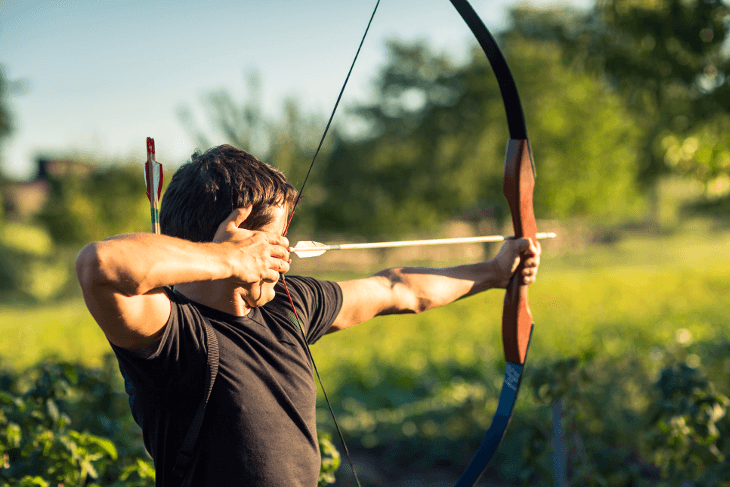Have you ever wanted to hunt people down and shoot them with your bow—but not in a “bloodlust-y” kind of way, and more akin to the spirit of sportsmanship?
If that describes you, boy have we got the sport for you.
In the post below, we’ll discuss archery tag—what it is, how it got started, and how (and where!) to play. Let’s start at the beginning:
What is Archery Tag, Exactly?
Ever play All-In Dodgeball, where two teams square off and throw balls at each other, and if you get hit, you’re out? Archery Tag is just like that, but with bows and arrows.
REAL bows and arrows, you ask? No, of course not. Don’t be crazy. Players attempt to hit each other with foam-tipped arrows, which are designed specifically to not cause injury, and thus allow players to enjoy the thrill of competition and work on improving their archery skills, while remaining in a safe and respectful environment.
The nice thing is, archery Tag is a sport that can be enjoyed by people off all ages. Here’s a video by Archer’s Arena in Toronto:
So where’d this come from?
A Brief History of Archery Tag
Archery Tag was created by John Jackson, the Founder and CEO of Global Archery Products. As Jackson tells it, the initial inspiration for the sport came to him while he was working on an archery product design for a manufacturer. According to the official Archery Tag website, at some point during that process, he had the idea of creating foam-tipped arrows and allowing people to shoot one another with them for fun. Acting immediately to bring his newly-conceived brainchild to life, Jackson constructed his first prototype in approximately an hour, and swiftly thereafter, had his design patented and dubbed the “NON-LETHAL ARROW.”
Over time, Jackson would tweak the original design for his arrow and make a few alterations to the riser of the bow used to fire it, ensuring that bow and arrow would mesh together more cleanly. In early 2011, with everything just right, Jackson introduced the official Archery Tag equipment to the world, and with it, the eponymous sport.
However, it is only with the release of the Hunger Games movie franchise, starting in 2012, 10 months after Jackson had created Archery Tag, that interest in it truly exploded. As seen here, many are quick to draw parallels between Archery Tag and the competition depicted in the films, seeing the former as a safe, non-lethal and family-friendly equivalent of the latter. For his part, Jackson has said that he was not initially aware of the Hunger Games films, but was happy to integrate their style, spirit, and image into his marketing and presentation, even staging Archery Tag events at premiers for each film in the series.
Today, Archery Tag has become—or, more accurately, is gradually becoming—a global phenomenon. It has been licensed in at least 170 locations in the United States alone, from places like Queens and Staten Island, New York on the east coast, to Rocklin, California in the west. Additionally, the sport is currently enjoyed by people in an incredible 65 countries, including such places as Peru, Russia, Saudi Arabia and significant portions of Asia. In many of these places, there are even Archery Tag tournaments in which players compete for cash prizes.
So, how do you play? Let’s take a look at two of the most popular styles:

The Rules of the Game
The official Archery Tag website provides an excellent explanation of the rules of the game, which we will summarize below. Broadly speaking, there are two ways to play Archery Tag: League Style and Elimination Style. Each of these styles has some rules that are unique to it, but before diving into the relevant nuances that differentiate these modes of play, we will first describe the general rules that are common to both.
General Rules
All forms of Archery Tag are played with two teams of five players each. The sport is played on a field divided into three zones—two “attack zones” on opposite sides of the field, and one “safe zone” or “neutral zone” located between the two attack zones. Players may only fire upon one another when they are in their own team’s respective attack zone, and no player may deliberately hit another player who is in the safe zone. Each attack zone contains large objects behind which players can seek cover from enemy fire.
The purpose of the safe zone is to give players a place from which to retrieve stray arrows while not having to worry about enemy fire. When going to the safe zone to gather arrows, players must leave their attack zone only through their end lines, and may only return to their respective attack zones through their end lines.
However, excessive loitering in the safe zone is not allowed. The referee is required to issue a warning to any player who remains in the safe zone for more than five seconds at a time. A second such infraction results in either a point deduction (if playing under League Style) or elimination from the game (if playing under Elimination Style).
If a team has more than five players, the excess players are required to stay in a designated area off on the sideline. Substitutions are to be made “live”—that is, with no stoppage in play—and the departing player must hand his bow to the incoming player before leaving. There are to be no stoppages in play, unless there is some kind of equipment safety issue, or a player happens to get injured. In the event of an injury, other players are to notify the referee immediately.
Whether it is played under League Style or Elimination style, Archery Tag is typically played under a time limit of 5 to 10 minutes, or perhaps is played in two halves of 5 minutes each.
Players are to wear protective masks at all times during play to shield their faces from oncoming arrows. Players are only to use bows and arrows for their intended purposes within Archery Tag, and may not do such things as use their bows like clubs with which to knock arrows out of the air or strike other players. Violent behavior, foul language or obscene taunts or hand gestures will not be tolerated under any circumstances, and all players are expected to respect and follow the commands of the referee at all times.
All games of Archery Tag begin with a stage known as the “Opening Rush.” At the start of each game, bows are situated along the end lines of each attack zone and arrows are left within the safe zone. Players take their positions in their attack zones and, when the referee gives the signal, dash into the safe zone to gather as many arrows as possible; players then speedily return to their respective attack zones and begin firing on their opponents.
In both League Style and Elimination Style, each team has a 5-point target on its side of the field, but the target has different functions depending on which style of the game is played.
Now let’s take a look at the differences between the two types of play:
League Style
The League Style of Archery Tag is also known as Points Style, and as this alternative name suggests, in this form of the game, players play for points. Points are allotted as follows: for hitting another player with an arrow anywhere on his body, clothing or equipment (including the bow, arrows, mask, etc), a player earns 1 point; for shooting a spot completely out of the opposing teams 5-spot target, a player earns 2 points; and for catching an arrow in mid-flight, a player earns 3 points.
The team with the most total points at the expiration of the time limit wins the game.
In the case of a tie, the game will enter into sudden death overtime. Under sudden death rules, each player will begin with at least one arrow. At a signal from the referee, both teams will begin firing upon one another, and the first team to score a legal hit upon a player of the other team will be declared the winner.
As mentioned above in the General Rules section, under League Style rules, remaining in the safe zone for more than five seconds at a time will result in a point deduction for the offending player. 1 point will be deducted for each instance of this after the player’s first offense.
League Style is perhaps the best form of the game to play for novice players, as when a player is hit, he is not eliminated from the game. This allows players to shift their focus to scoring points rather than evading the arrows of other players, allowing for a much faster pace of play.
Elimination Style
Under Elimination Style rules, a player is eliminated from the game if he is hit by an opposing player’s arrow anywhere on his body, clothing or any of his equipment, or if his arrow happens to be caught by an opposing player. When a player is eliminated, he must leave the field.
However, a formerly eliminated player may be recalled to the field if one of his teammates shoots out a spot from the opposing team’s 5-point target, or if a teammate catches an opponent’s arrow.
The game goes on either until one team has completely eliminated the other, or until the time limit expires. The team that is able to completely eliminate the other will be the winner. If neither team is completely eliminated before time expires, the team with the most players remaining will be declared the winner.
If both teams have the same amount of players remaining when time runs out, the game will enter into sudden death overtime. Just as in League Style, each player must begin with at least one arrow, and at a signal from the referee, players will fire upon one another until a player from one team scores a legal hit upon a player of the other team. The first team to score a legal hit will be the winner.
A player will be eliminated from the game if he remains in the safe zone for more than five seconds at a time on more than one occasion.
Elimination style is more suitable for more experienced players, or for those who enjoy an added element of risk. Since when a player is hit, he is eliminated from the game, players will have to be much more cautious and evasive to succeed.
Interested? What to Learn More?
Awesome! Head over to the Archery Tag “Directory” page to learn more, and find the nearest Archery Tag location near you. The game is not only a great way to experience archery in a new and exciting way, but it’s a great workout—all that running around really gets your blood pumping. Have fun!



